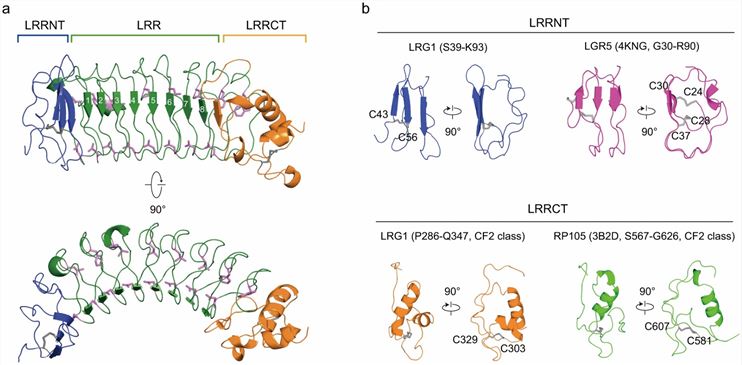What is LRG1 Protein
Leucine-rich α-2-glycoprotein 1 (LRG1) is a glycoprotein in the leucine-rich repeat (LRR) family that sits at the nexus of cellular communication and signaling.
LRG1 is a glycoprotein that has attracted widespread attention in recent years. It belongs to the LRR family, which is characterized by the presence of tandem repeats of leucine-rich motifs. These motifs are involved in protein-protein interactions, suggesting that LRG1 may play a key role in cellular communication and signaling.
The human LRG1 gene is located on chromosome 19q13.33, and its expression is regulated by multiple factors, including inflammatory stimuli. LRG1 is synthesized and secreted by liver cells, and its circulating levels can be detected in serum, making it a potential biomarker for various health conditions.
 Figure 1. Structure of human LRG1 (Yang, J., et al. 2023)
Figure 1. Structure of human LRG1 (Yang, J., et al. 2023)The Function of LRG1 Protein
The physiological functions of LRG1 are diverse and multifaceted, reflecting its involvement in different biological processes. One of its main effects is related to immune response. LRG1 has been identified as an acute-phase reactant, meaning its levels are significantly elevated in response to inflammation or infection. This suggests its potential as a biomarker for monitoring inflammatory conditions.
Additionally, research suggests that LRG1 may help regulate angiogenesis, highlighting its potential as a therapeutic target for diseases characterized by abnormal blood vessel formation.
LRG1-Related Diseases
Dysregulation of LRG1 is associated with multiple diseases, revealing its diagnostic and prognostic implications.
- Cancer
LRG1 levels are elevated in the serum of cancer patients, suggesting its potential as a biomarker for certain malignancies. In addition, LRG1 may play a role in tumor progression by promoting angiogenesis, which provides cancer cells with the blood supply needed for growth and proliferation.
- Cardiovascular Diseases
In cardiovascular disease, LRG1 has emerged as a potential marker for assessing the risk and severity of diseases such as coronary artery disease. Its involvement in inflammation and angiogenesis makes it a promising candidate for further investigation in cardiovascular research.
- Inflammatory Disorders
Rheumatoid arthritis, an autoimmune disease characterized by joint inflammation, is associated with alterations in LRG1 levels. Understanding the role of LRG1 in these diseases could open avenues for developing targeted therapies and improving patient outcomes.
LRG1 Related Signaling Pathways
To understand the impact of LRG1 on health and disease, it is critical to explore the signaling pathways through which it operates. While the exact mechanisms are still under investigation, several pathways have been identified that provide insights into the complex roles of LRG1.
One of these pathways involves the interaction of LRG1 with transforming growth factor-β (TGF-β), a key player in cell proliferation, differentiation, and immune responses. LRG1 has been shown to regulate TGF-β signaling, affecting cellular processes such as epithelial-mesenchymal transition (EMT) and fibrosis. These findings suggest that LRG1 is involved in tissue remodeling and repair.
Another pathway of interest is the involvement of LRG1 in the regulation of angiogenesis. LRG1 appears to interact with vascular endothelial growth factor (VEGF). VEGF is a key factor in blood vessel formation, and by affecting VEGF signaling, LRG1 may affect angiogenesis, thereby affecting various physiological and pathological processes.
Applications of LRG1 in Biomedical Research
The fascination of LRG1 lies beyond understanding its complex molecular structure. It holds great promise in biomedical applications.
As a potential biomarker, LRG1 offers a non-invasive method to diagnose and monitor various diseases. In cancer research, its association with tumor progression and angiogenesis makes it a target for the development of new therapeutic strategies. Inhibiting LRG1 can prevent tumor growth and spread, providing new avenues for cancer treatment. In cardiovascular health, LRG1 has potential as a prognostic marker, and monitoring LRG1 levels in high-risk populations could enable early intervention and preventive measures, potentially reducing the burden of cardiovascular disease globally. Additionally, by modulating LRG1 levels or its interactions with key signaling pathways, researchers could develop interventions that specifically address the underlying causes of inflammatory diseases, providing more effective and tailored treatments.
From its role as a biomarker to its involvement in signaling pathways affecting angiogenesis and immune responses, LRG1 emerges as a key player in a complex molecular biological network. As research continues to unravel its mysteries, applications of LRG1 in diagnosis, treatment, and personalized medicine have the potential to reshape how we address a variety of medical challenges.
Recommended Products for LRG1 Protein
| Cat.# | Species | Product name | Source (Host) | Tag |
|---|---|---|---|---|
| LRG1-141H | Human | Recombinant Human LRG1, His tagged | Human Cell | His |
| LRG1-330H | Human | Recombinant Human LRG1 | Human Cell | N/A |
| LRG1-142H | Human | Recombinant Human LRG1, Fc tagged | Human Cell | His |
| LRG1-54H | Human | Recombinant Human LRG1 protein, T7/His-tagged | E.coli | T7/His |
| LRG1-159H | Human | Recombinant Human LRG1 Protein, Fc/HIS-tagged | HEK293 | Fc/His |
| LRG1-3618H | Human | Recombinant Human LRG1 Protein, Myc/DDK-tagged, C13 and N15-labeled | HEK293T | Myc/DDK |
| LRG1-4704H | Human | Recombinant Human LRG1 Protein, GST-tagged | Wheat Germ | GST |
| Lrg1-1986M | Mouse | Recombinant Mouse Lrg1 protein, His & GST-tagged | E.coli | His/GST |
| Lrg1-1746M | Mouse | Recombinant Mouse Lrg1 Protein, His-tagged | E.coli | N-His |
| Lrg1-1987R | Rat | Recombinant Rat Lrg1 protein, His & GST-tagged | E.coli | His/GST |
Reference
- Yang, J., et al. Crystal structure of LRG1 and the functional significance of LRG1 glycan for LPHN2 activation. Exp Mol Med. 2023, 55: 1013–1022.

